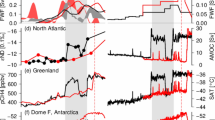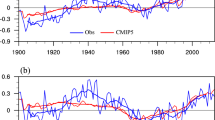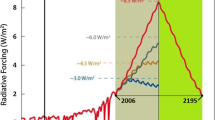Abstract
Observational records and climate model projections reveal a considerable decline in the Atlantic Meridional Overturning Circulation (AMOC). Changes in the AMOC can have a significant impact on the global climate. Sustained warming due to increased greenhouse gas emissions is projected to weaken the AMOC, which in turn can lead to changes in the location of Inter-tropical convergence zone (ITCZ), oceanic and atmospheric large-scale circulation, tropical precipitation and regional monsoons. Using proxy records, observations and CMIP6 simulations of IITM Earth System Model (IITM-ESM), we investigate the changes in the AMOC and associated changes in the large-scale circulation and precipitation patterns over the South Asian monsoon region. Transient CO2 simulation and additional model sensitivity experiments with realistic surface heat and freshwater perturbation anomalies under the experimental protocol of Flux Anomaly Forcing Model Intercomparison Project (FAFMIP) performed with IITM-ESM reveal a decline in the strength of AMOC. The weakening of AMOC is associated with enhanced heat and freshwater forcing in the North Atlantic resulting in the reduction of northward oceanic heat transport and an enhanced northward atmospheric heat transport. Changes in AMOC lead to weakening of large-scale north–south temperature gradient and regional land-sea thermal gradient, which in turn weaken the regional Hadley circulation and, monsoon circulation over the South Asian region. Both the FAFMIP and transient CO2 experiments reveal consistent results of weakening South Asian Monsoon circulation with a decline of AMOC, while precipitation exhibits contrasting responses as precipitation changes are dominated by the thermodynamic response. The suite of observational and numerical analysis provides a mechanistic hypothesis for the weakening of South Asian monsoon circulation concomitant with a weakening of AMOC in a warming climate.















Similar content being viewed by others
References
Altabet MA, Higginson MJ, Murray DW (2002) The effect of millennial-scale changes in Arabian Sea denitrification on atmospheric CO2. Nature 415:159–162
Belkin IM, Levitus S, Antonov J, Malmberg SA (1998) “Great salinity anomalies” in the North Atlantic. Prog Oceanogr. https://doi.org/10.1016/S0079-6611(98)00015-9
Buckley MW, Marshall J (2016) Observations, inferences, and mechanisms of the Atlantic meridional overturning circulation: a review. Rev Geophys. https://doi.org/10.1002/2015RG000493
Cheng W, Chiang JCH, Zhang D (2013) Atlantic meridional overturning circulation (AMOC) in CMIP5 Models: RCP and historical simulations. J Clim 26:7187–7197. https://doi.org/10.1175/JCLI-D-12-00496.1
Chiang JCH, Cheng W, Bitz CM (2008) Fast teleconnections to the tropical Atlantic sector from Atlantic thermohaline adjustment. Geophys Res Lett 35:L07704. https://doi.org/10.1029/2008GL033292
Cunningham SA, Kanzow T, Rayner D et al (2007) Temporal variability of the Atlantic meridional overturning circulation at 26.5°N. Science. https://doi.org/10.1126/science.1141304
Delworth TL, Greatbatch RJ (2000) Multidecadal thermohaline circulation variability driven by atmospheric surface flux forcing. J Clim. https://doi.org/10.1175/1520-0442(2000)013%3c1481:MTCVDB%3e2.0.CO;2
Delworth T, Manabe S, Stouffer RJ (1993) Interdecadal variations of the thermohaline circulation in a coupled ocean-atmosphere model. J Clim 6:1993–2011
Delworth TL, Broccoli AJ, Rosati A et al (2006) GFDL’s CM2 Global coupled climate models. Part I: formulation and simulation characteristics. J Clim 19:643–674
Dickson RR, Meincke J, Malmberg SA, Lee AJ (1988) The “great salinity anomaly” in the Northern North Atlantic 1968–1982. Prog Oceanogr. https://doi.org/10.1016/0079-6611(88)90049-3
Donohoe A, Marshall J, Ferreira D, Mcgee D (2013) The relationship between ITCZ location and cross-equatorial atmospheric heat transport: from the seasonal cycle to the last glacial maximum. J Clim 26:3597–3618. https://doi.org/10.1175/JCLI-D-12-00467.1
Ek MB (2003) Implementation of Noah land surface model advances in the National Centers for Environmental Prediction operational mesoscale Eta model. J Geophys Res. https://doi.org/10.1029/2002JD003296
Endo H, Kitoh A (2014) Thermodynamic and dynamic effects on regional monsoon rainfall changes in a warmer climate. Geophys Res Lett 41:1704–1710. https://doi.org/10.1002/2013GL059158
Frierson DMW, Hwang Y-T, Fučkar NS et al (2013) Contribution of ocean overturning circulation to tropical rainfall peak in the Northern Hemisphere. Nat Geosci 6:940–944. https://doi.org/10.1038/ngeo1987
Ganai M, Phani Murali Krishna R, Mukhopadhyay P, Mahakur M (2015) The impact of revised simplified Arakawa-Schubert scheme on the simulation of mean and diurnal variability associated with active and break phases of of Indian summer monsoon using CFSv2. J Geophys Res Atmos. https://doi.org/10.1002/2014JD021636.Received
Gregory JM, Dixon KW, Stouffer RJ et al (2005) A model intercomparison of changes in the Atlantic thermohaline circulation in response to increasing atmospheric CO2 concentration. Geophys Res Lett. https://doi.org/10.1029/2005GL023209
Gregory JM, Bouttes N, Griffies SM et al (2016a) The Flux-Anomaly-Forced Model Intercomparison Project (FAFMIP) contribution to CMIP6: investigation of sea-level and ocean climate change in response to CO2 forcing. Geosci Model Dev. https://doi.org/10.5194/gmd-9-3993-2016
Gregory JM, Bouttes N, Griffies SM et al (2016b) The flux-anomaly-forced model intercomparison project (FAFMIP) contribution to CMIP6: investigation of sea-level and ocean climate change in response to CO2 forcing. Geosci Model Dev 9:3993–4017. https://doi.org/10.5194/gmd-9-3993-2016
Griffies SM (2009) Elements of MOM4p1, GFDL Ocean Group Technical Report 6. NOAA/Geophysical Fluid Dynamics Laboratory.
Griffies SM, Tziperman E (1995) A linear thermohaline oscillator driven by stochastic atmospheric forcing. J Clim. https://doi.org/10.1175/1520-0442(1995)008%3c2440:ALTODB%3e2.0.CO;2
Han J, Pan H-L (2011) Revision of convection and vertical diffusion schemes in the NCEP global forecast system. Weather Forecast 26:520–533. https://doi.org/10.1175/WAF-D-10-05038.1
Haug G, Hughen K (2000) Southward migration of the intertropical convergence zone through. Science 254:487–504. https://doi.org/10.1126/science.1059725
Haug GH, Hughen KA, Sigman DM et al (2001) Southward migration of the intertropical convergence zone through the holocene. Science. https://doi.org/10.1126/science.1059725
Haywood JM, Jones A, Dunstone N et al (2016) The impact of equilibrating hemispheric albedos on tropical performance in the HadGEM2-ES coupled climate model. Geophys Res Lett 43:395–403. https://doi.org/10.1002/2015GL066903
Hsu PC, Li T, Murakami H, Kitoh A (2013) Future change of the global monsoon revealed from 19 CMIP5 models. J Geophys Res Atmos. https://doi.org/10.1002/jgrd.50145
Huang P, Xie S, Hu K et al (2013) Patterns of the seasonal response of tropical rainfall to global warming. Nat Geosci 6:357–361. https://doi.org/10.1038/ngeo1792
Huffman GJ, Bolvin DT, Nelkin EJ et al (2007) The TRMM multisatellite precipitation analysis (TMPA): quasi-global, Multiyear, Combined-Sensor Precipitation Estimates at Fine Scales. J Hydrometeorol. https://doi.org/10.1175/JHM560.1
Jackson LC (2013) Shutdown and recovery of the AMOC in a coupled global climate model: the role of the advective feedback. Geophys Res Lett 40:1182–1188. https://doi.org/10.1002/grl.50289
Johns WE, Beal LM, Baringer MO et al (2008) Variability of shallow and deep western boundary currents off the Bahamas during 2004–05: results from the 26°N RAPID–MOC Array. J Phys Oceanogr 38:605–623. https://doi.org/10.1175/2007JPO3791.1
Johns WE, Baringer MO, Beal LM et al (2011) Continuous, array-based estimates of atlantic ocean heat transport at 26.5°N. J Clim. https://doi.org/10.1175/2010jcli3997.1
Kanzow T, Cunningham SA, Rayner D et al (2007) Observed flow compensation associated with the MOC at 26.5°N in the Atlantic. Science. https://doi.org/10.1126/science.1141293
Kanzow T, Cunningham SA, Johns WE et al (2010a) Seasonal variability of the Atlantic meridional overturning circulation at 26.5°N. J Clim. https://doi.org/10.1175/2010jcli3389.1
Kanzow T, Cunningham SA, Johns WE et al (2010b) Seasonal variability of the Atlantic meridional overturning circulation at 26.5°N. J Clim 23:5678–5698. https://doi.org/10.1175/2010JCLI3389.1
Kirtman B, Power SB, Adedoyin JA, et al (2013) Near-term Climate Change: Projections and Predictability. In: Climate Change 2013 the Physical Science Basis: Working Group I Contribution to the Fifth Assessment Report of the Intergovernmental Panel on Climate Change
Kitoh A, Yukimoto S, Noda A, Motoi T (1997) Simulated changes in the Asian summer monsoon at times of increased atmospheric CO2. J Meteorol Soc Jpn Ser II 75:1019–1031. https://doi.org/10.2151/jmsj1965.75.6_1019
Kripalani RH, Oh JH, Kulkarni A et al (2007) South Asian summer monsoon precipitation variability: coupled climate model simulations and projections under IPCC AR4. Theor Appl Climatol 90:133–159. https://doi.org/10.1007/s00704-006-0282-0
Lau K-M, Li M-T (1984) The monsoon of East Asia and its global associations: a survey. Bull Am Meteorol Soc. https://doi.org/10.1175/1520-0477(1984)065%3c0114:tmoeaa%3e2.0.co;2
Lee JY, Wang B (2014) Future change of global monsoon in the CMIP5. Clim Dyn 42:101–119. https://doi.org/10.1007/s00382-012-1564-0
Li C, Yanai M (1996) The onset and interannual variability of the asian summer monsoon in relation to land-sea thermal contrast. J Clim. https://doi.org/10.1175/1520-0442(1996)009%3c0358:TOAIVO%3e2.0.CO;2
Li X, Ting M, Li C, Henderson N (2015) Mechanisms of Asian summer monsoon changes in response to anthropogenic forcing in CMIP5 models. J Clim 28:4107–4125. https://doi.org/10.1175/JCLI-D-14-00559.1
Liu W, Fedorov AV (2019) Global impacts of arctic sea ice loss mediated by the Atlantic meridional overturning circulation. Geophys Res Lett 46:944–952. https://doi.org/10.1029/2018GL080602
Locarnini RA, Mishonov AV, Antonov JI, Boyer TP, Garcia HE, Baranova OK, Zweng MM, Johnson DR (2010) World Ocean Atlas 2009, Volume 1: Temperature. In: Levitus S (ed) NOAA Atlas NESDIS 68. U.S. Government Printing Office, Washington, DC, p 184
Mantsis DF, Clement AC (2009) Simulated variability in the mean atmospheric meridional circulation over the 20th century. Geophys Res Lett. https://doi.org/10.1029/2008GL036741
McCarthy G, Frajka-Williams E, Johns WE et al (2012) Observed interannual variability of the Atlantic meridional overturning circulation at 26.5°N. Geophys Res Lett. https://doi.org/10.1029/2012gl052933
McGee D, Donohoe A, Marshall J, Ferreira D (2014) Changes in ITCZ location and cross-equatorial heat transport at the last glacial maximum, Heinrich Stadial 1, and the mid-Holocene. Earth Planet Sci Lett. https://doi.org/10.1016/j.epsl.2013.12.043
McGee D, Moreno-Chamarro E, Green B et al (2018) Hemispherically asymmetric trade wind changes as signatures of past ITCZ shifts. Q Sci Rev 180:214–228. https://doi.org/10.1016/j.quascirev.2017.11.020
Meehl GA, Arblaster JM, Tebaldi C (2005) Understanding future patterns of increased precipitation intensity in climate model simulations. Geophys Res Lett. https://doi.org/10.1029/2005GL023680
Mei R, Ashfaq M, Rastogi D et al (2015) Dominating controls for wetter South Asian summer monsoon in the twenty-first century. J Clim 28:3400–3419. https://doi.org/10.1175/JCLI-D-14-00355.1
Menon A, Levermann A, Schewe J et al (2013) Consistent increase in Indian monsoon rainfall and its variability across CMIP-5 models. Earth Syst Dyn 4:287–300. https://doi.org/10.5194/esd-4-287-2013
Mikolajewicz U, Voss R (2000) The role of the individual air-sea flux components in CO2-induced changes of the ocean’s circulation and climate. Clim Dyn. https://doi.org/10.1007/s003820000066
Mohtadi M, Prange M, Oppo DW et al (2014) North Atlantic forcing of tropical Indian Ocean climate. Nature 509:76
Moorthi S, Pan HL, Caplan P (2001) Changes to the 2001 NCEP operational MRF/AVN global analysis/forecast system. NWS Technical Procedures Bulletin 484. NCEP, Silver Spring, MD, p 14
Parsons LA, Yin J, Overpeck JT et al (2014) Influence of the Atlantic meridional overturning circulation on the monsoon rainfall and carbon balance of the American tropics. Geophys Res Lett 41:146–151. https://doi.org/10.1002/2013GL058454
Rahmstorf S, Ganopolski A (1999) Long-term global warming scenarios computed with an efficient coupled climate model. Clim Change. https://doi.org/10.1023/A:1005474526406
Rahmstorf S, Box JE, Feulner G et al (2015) Exceptional twentieth-century slowdown in Atlantic Ocean overturning circulation. Nat Clim Change 5:475–480. https://doi.org/10.1038/nclimate2554
Rajeevan M, Gadgil S, Bhate J (2010) Active and break spells of the indian summer monsoon. J Earth Syst Sci. https://doi.org/10.1007/s12040-010-0019-4
Rayner NA, Parker DE, Horton EB et al (2003) Global analyses of sea surface temperature, sea ice, and night marine air temperature since the late nineteenth century. J Geophys Res 108:4407. https://doi.org/10.1029/2002JD002670
Rayner D, Hirschi JJM, Kanzow T et al (2011) Monitoring the Atlantic meridional overturning circulation. Deep Res Part II Top Stud Oceanogr. https://doi.org/10.1016/j.dsr2.2010.10.056
Rhein M (2014) Observations: ocean pages. Clim Change 2013. Phys Sci Basis. https://doi.org/10.1017/cbo9781107415324.010
Saha A, Ghosh S, Sahana AS, Rao EP (2014) Failure of CMIP5 climate models in simulating post-1950 decreasing trend of Indian monsoon. Geophys Res Lett 41:7323–7330. https://doi.org/10.1002/2014GL061573
Sévellec F, Fedorov AV, Liu W (2017) Arctic sea-ice decline weakens the Atlantic meridional overturning circulation. Nat Clim Chang 7:604–610. https://doi.org/10.1038/NCLIMATE3353
Sikka DR, Gadgil S (1980) On the Maximum Cloud Zone and the ITCZ over Indian, Longitudes during the Southwest Monsoon. Mon Weather Rev 108:1840–1853
Sinha A, Kathayat G, Cheng H et al (2015) Trends and oscillations in the Indian summer monsoon rainfall over the last two millennia. Nat Commun 6:1–8. https://doi.org/10.1038/ncomms7309
Srokosz M, Baringer M, Bryden H et al (2012) Past, present, and future changes in the atlantic meridional overturning circulation. Bull Am Meteorol Soc. https://doi.org/10.1175/BAMS-D-11-00151.1
Stocker TF, Allen SK, Bex V, Midgley PM (2013) Climate change 2013 The Physical Science Basis Working Group I Contribution to the Fifth Assessment Report of the Intergovernmental Panel on Climate Change
Stouffer RJ, Yin J, Gregory JM et al (2006) Investigating the cause of the response of the thermohaline circulation to past and future climage changes. J Clim. https://doi.org/10.1175/JCLI3689.1
Stowasser M, Annamalai H, Hafner J (2009) Response of the South Asian summer monsoon to global warming: mean and synoptic systems. J Clim 22:1014–1036. https://doi.org/10.1175/2008JCLI2218.1
Sun Y, Clemens SC, Morrill C et al (2011) Influence of Atlantic meridional overturning circulation on the East Asian winter monsoon. Nat Geosci 5:46–49. https://doi.org/10.1038/ngeo1326
Sun C, Li J, Jin FF, Ding R (2013) Sea surface temperature inter-hemispheric dipole and its relation to tropical precipitation. Environ Res Lett. https://doi.org/10.1088/1748-9326/8/4/044006
Sutton RT, Hodson DLR (2005) Ocean science: Atlantic ocean forcing of North American and European summer climate. Science. https://doi.org/10.1126/science.1109496
Swapna P, Roxy MK, Aparna K et al (2014) The IITM earth system model: transformation of a seasonal prediction model to a long term climate model. Bull Am Meteorol Soc 96:115–119
Swapna P, Krishnan R, Sandeep N et al (2018) Long-Term climate simulations using the IITM earth system model (IITM-ESMv2) with focus on the south asian monsoon. J Adv Model Earth Syst 10:1127–1149. https://doi.org/10.1029/2017MS001262
Tanaka HL, Ishizaki N, Nohara D (2005) Intercomparison of the intensities and trends of hadley, walker and monsoon circulations in the global warming projections. SOLA. https://doi.org/10.2151/sola.2005-021
Taylor KE, Stouffer RJ, Meehl GA (2012) An overview of CMIP5 and the experiment design. Bull Am Meteorol Soc 93:485–498. https://doi.org/10.1175/BAMS-D-11-00094.1
Trenberth KE (1998) Atmospheric moisture residence times and cycling: implications for rainfall rates and climate change. Clim Change. https://doi.org/10.1023/A:1005319109110
Trenberth KE, Fasullo JT (2017) Atlantic meridional heat transports computed from balancing Earth’s energy locally. Geophys Res Lett. https://doi.org/10.1002/2016GL072475
Turner AG, Annamalai H (2012) Climate change and the South Asian summer monsoon. Nat Clim Change 2:587–595. https://doi.org/10.1038/nclimate1495
Ueda H, Iwai A, Kuwako K, Hori ME (2006) Impact of anthropogenic forcing on the Asian summer monsoon as simulated by eight GCMs. Geophys Res Lett. https://doi.org/10.1029/2005GL025336
Vellinga M, Wood RA (2002) Global climatic impacts of a collapse of the Atlantic thermohaline circulation. Clim Change. https://doi.org/10.1023/A:1016168827653
Vellinga M, Wood RA (2008) Impacts of thermohaline circulation shutdown in the twenty-first century. Clim Change 91:43–63. https://doi.org/10.1007/s10584-006-9146-y
Vial J, Cassou C, Codron F et al (2018) Influence of the Atlantic meridional overturning circulation on the tropical climate response to CO2 forcing. Geophys Res Lett. https://doi.org/10.1029/2018GL078558
Voigt A, Stevens B, Bader J, Mauritsen T (2013) The observed hemispheric symmetry in reflected shortwave irradiance. J Clim 26:468–477. https://doi.org/10.1175/JCLI-D-12-00132.1
Wang YJ, Cheng H, Edwards RL et al (2001) A high-resolution absolute-dated late pleistocene monsoon record from Hulu cave, China. Science. https://doi.org/10.1126/science.1064618
Wang J, Yang B, Ljungqvist FC et al (2017) Internal and external forcing of multidecadal Atlantic climate variability over the past 1,200 years. Nat Geosci. https://doi.org/10.1038/ngeo2962
Webster PJ, Magaña VO, Palmer TN et al (1998) Monsoons: processes, predictability, and the prospects for prediction. J Geophys Res 103:14451. https://doi.org/10.1029/97JC02719
Winton M (2000) A reformulated three-layer sea ice model. J Atmos Ocean Technol 17:525–531. https://doi.org/10.1175/1520-0426(2000)017%3c0525:ARTLSI%3e2.0.CO;2
Woollings T, Gregory JM, Pinto JG et al (2012) Response of the North Atlantic storm track to climate change shaped by ocean atmosphere coupling. Nat Geosci 5:313–317. https://doi.org/10.1038/ngeo1438
Xavier PK, Marzin C, Goswami BN (2007) An objective definition of the Indian summer monsoon season and a new perspective on the ENSO–monsoon relationship. Q J R Metero Soc A 133:937–948.
Zhang R, Delworth TL (2005) Simulated tropical response to a substantial weakening of the Atlantic thermohaline circulation. J Clim 18:1853–1860. https://doi.org/10.1175/JCLI3460.1
Zhang R, Delworth TL (2006) Impact of Atlantic multidecadal oscillations on India/Sahel rainfall and Atlantic hurricanes. Geophys Res LEtt 33:1–5. https://doi.org/10.1029/2006GL026267
Acknowledgements
We thank Director, IITM for extending full support for this research. The IITM-ESM simulations were performed on the IITM HPC Aaditya. IITM receives full support from the Ministry of Earth Sciences, Government of India. Author SN acknowledges the STEP program, ICTP, Italy. A part of the experiments and analysis was carried out at ICTP, Italy as a part of the STEP program. Freeware Ferret and NCL are used for the analysis of model simulations. All data sources are duly acknowledged.
Author information
Authors and Affiliations
Corresponding author
Additional information
Publisher's Note
Springer Nature remains neutral with regard to jurisdictional claims in published maps and institutional affiliations.
Rights and permissions
About this article
Cite this article
Sandeep, N., Swapna, P., Krishnan, R. et al. South Asian monsoon response to weakening of Atlantic meridional overturning circulation in a warming climate. Clim Dyn 54, 3507–3524 (2020). https://doi.org/10.1007/s00382-020-05180-y
Received:
Accepted:
Published:
Issue Date:
DOI: https://doi.org/10.1007/s00382-020-05180-y




